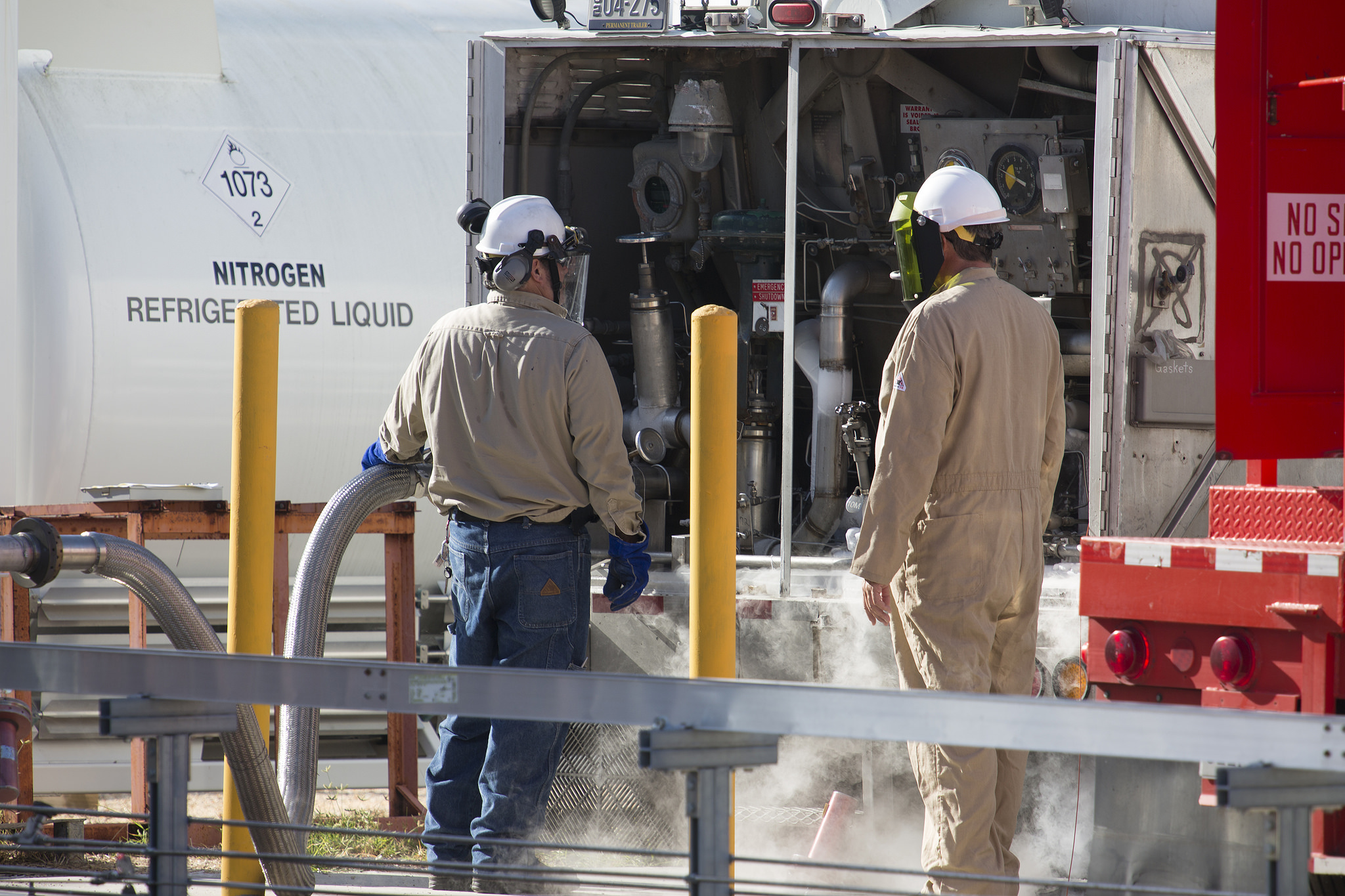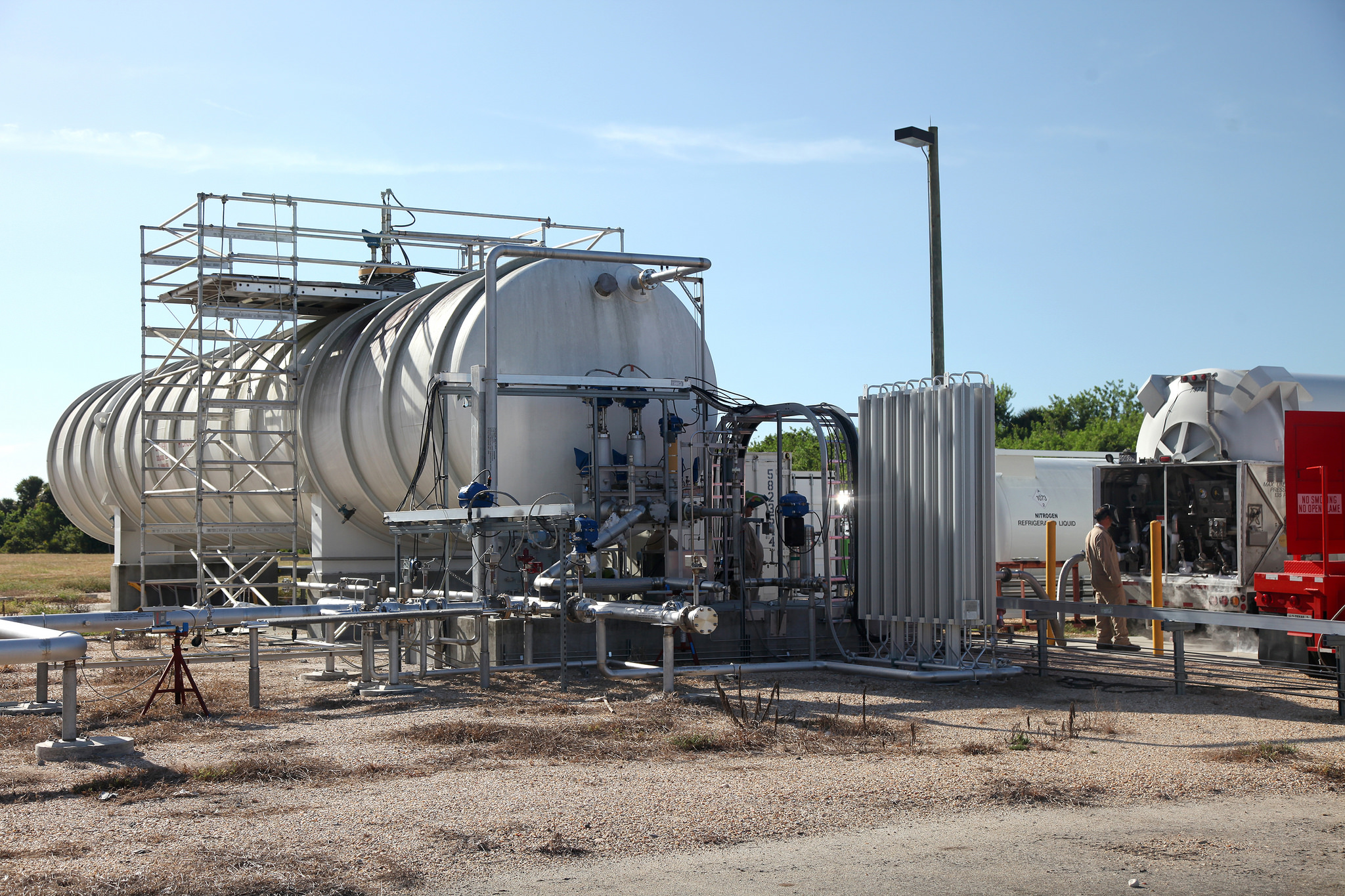
By Amanda Griffin and Linda Herridge
NASA’s John F. Kennedy Space Center
When NASA saved a shuttle-era storage facility at the agency’s Kennedy Space Center in Florida from demolition five years ago, engineers already had future in mind for what to do with the building. Some three years later, NASA transformed the hangar and installed test equipment at an adjacent field for testing a new ground operations demo unit for liquid hydrogen. The testing has come to a successful conclusion after 1.5 years.
The system is comprised of a 33,000 gallon liquid hydrogen storage tank recycled from the Titan Centaur program, with an internal cold heat exchanger supplied from a cryogenic refrigerator. The refrigerator, chiller and associated controls are housed in a metal storage container for insulation and to protect them from the corrosive sand and salt environment.
The system was designed, installed and tested by a team of civil servants and contractors from the center’s Cryogenic Test Laboratory, with key support from engineers at NASA’s Glenn Research Center in Cleveland and Stennis Space Center in Mississippi.
Testing was done in three phases over 18 months between April 2015 and September 2016. The system was put through its paces using an increasing amount of stored hydrogen – 30, 60 and 90 percent, respectively. The system was tested for three main objectives: zero boil-off, liquefaction and propellant densification.
According to Bill Notardonato, the demo unit’s principal investigator in the Exploration Research and Technology Directorate at Kennedy, a zero boil-off capability is a prime candidate for use by the Ground Systems Development and Operations Program (GSDO) at the center, potentially saving NASA millions of dollars compared to previous operations.
Notardonato’s team is consulting with GSDO on the design of the new pad B liquid hydrogen tank and future launch pad systems.
“For Space Launch System launches, GSDO will fill the rocket’s core stage and interim cryogenic upper stage with hundreds of thousands of gallons of liquid hydrogen,” said Shawn Quinn, GSDO assistant program manager. “An important feature of the new zero boil-off technology is the potential to reduce long-term energy costs and liquid hydrogen commodity costs.”
Kennedy is preparing for the first integrated launch of NASA’s Space Launch System and Orion spacecraft. Upgrades to Launch Pad 39B, where the rocket and Orion will launch on a test flight in late 2018, include a 1.4-million-gallon hydrogen tank. That’s 50 percent larger than the current tank.
“The goal would be to integrate the unit’s heat exchange system into the new tank, saving GSDO money by eliminating the loss of hydrogen,” Notardonato said. “By accomplishing zero boil-off of liquid hydrogen, we could save one dollar in hydrogen for every 20 cents spent on electricity to keep it cooled.”
The new unit contains a cooling system that removes heat and vents it into the atmosphere. What is left is super-cooled hydrogen that is stored at minus 423 degrees Fahrenheit.
Liquefaction takes gaseous hydrogen and turns it into a liquid. Instead of the usual method of compression and expansion, the hydrogen is flowed into the tank and cooled down using helium refrigerant from a cryogenic refrigerator.
Notardonato said helium refrigerant is a good choice, because it is a common refrigerant that can meet the needs of an in-situ resource utilization process in deep space.
Propellant densification, or cooling a liquid below its normal boiling point to increase the storage density, was the most challenging objective. The new system performed flawlessly, transforming the liquid hydrogen into the world’s largest volume of hydrogen slush at minus 435 degrees Fahrenheit.
Some commercial companies are using densified oxygen for their rockets, enabling cost-effective reusability of their core stages. Densifying oxygen is much easier than hydrogen, but the benefits of densified hydrogen could be far greater, according to Notardonato.
Notardonato said the next goal is to take the portable liquid hydrogen system to another center for densified hydrogen engine testing that could be used for a future commercial launch vehicle, helping to curb the cost of access to space. In parallel, the results are being shared with the GSDO Program and in-situ resource utilization mission planners to increase awareness of this new capability.
“It’s an exciting new technology that will benefit NASA’s Journey to Mars and has the potential to also benefit the nation’s efforts to establish alternative energy sources,” Quinn said.























